CHLORIN E6
- CAS NO.:19660-77-6
- Empirical Formula: C34H36N4O6
- Molecular Weight: 596.67
- MDL number: MFCD08669566
- EINECS: 243-209-4
- SAFETY DATA SHEET (SDS)
- Update Date: 2024-12-18 14:08:52
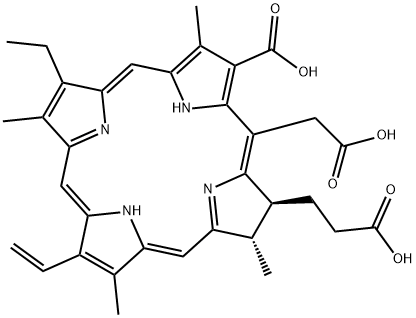
What is CHLORIN E6?
Description
Chlorin E6 is a natural molecule and a promising photosensitizer. Chlorin E6 is isolated from renewable natural sources. Chlorin E6 is an attractive photodynamic therapy (PDT) drug candidate because of (1) its high absorption in the red spectral region, and (2) its low cost to make compared to other porphyrin-based PDT drugs. Chlorin E6 exhibits advantageous photophysical properties for PDT such as having long lifetimes in their photoexcited triplet states and high molar absorption in the red region of the visible spectrum. Moreover, a 664-nm laser light can penetrate tissue deeper that the 630-nm laser light used for other PDT drugs. Chlorin E6 is an important starting material for making PDT drug Talaporfin sodium (mono-L-aspartyl chlorin e6 or NPe6).
PDT is currently being used as an alternative therapeutic modality for a variety of malignant tumors. Studies have examined antitumor activity of Ce6-induced PDT (Ce6-PDT) both in vitro and in vivo using a rat tumor models. In one study three-week-old male Sprague-Dawley (SD) rats were inoculated s.c. on the right flank with 5x106 RK3E-ras cells. The animals were administered i.v. with Ce6 (10 mg/kg) and 24 h later, PDT was performed using a laser diode at a light dose of 100 J/cm2. Ce6-PDT generated reactive oxygen species and led to significant growth inhibition in RK3E-ras cell. In addition, Ce6-PDT induced apoptosis through the activation of caspase-3 and its downstream target, PARP cleavage. The protein level of anti-apoptotic bcl-2 was also reduced by Ce6-PDT in RK3E-ras cells. In in vivo experiments, application of Ce6- PDT led to a significant reduction of tumor size. PCNA immunostaining and TUNEL assay revealed that Ce6-PDT inhibited tumor cell proliferation and increased apoptosis. (source: Oncology Reports, 2009, 22(5). 1085-1091.)
The Uses of CHLORIN E6
Chlorin E6 is a photosensitizer.The conjugates of gold nanorods and chlorin e6 enhance the fluorescence detection and photodynamic therapy (PDT) of cancers.
What are the applications of Application
Chlorin e6 is a naturally occurring chlorin commonly used photosensitizer and can be used as a nanotechnology delivery tool
Definition
ChEBI: Chlorin E6 is a member of chlorins.
Properties of CHLORIN E6
| alpha | D20 -141° in acetone |
| storage temp. | -20°C Freezer |
| solubility | DMSO (Slightly), Isopropanol (Slightly, Heated, Sonicated) |
| form | Solid |
| Boiling point: | 1093.7±60.0 °C(Predicted) |
| Density | 1.306±0.06 g/cm3(Predicted) |
| color | Black |
| EPA Substance Registry System | 21H,23H-Porphine-7-propanoic acid, 3-carboxy-5-(carboxymethyl)-13-ethenyl-18-ethyl-7,8-dihydro-2,8,12,17-tetramethyl-, (7S,8S)- (19660-77-6) |
Safety information for CHLORIN E6
| Signal word | Warning |
| Pictogram(s) |
 Exclamation Mark Irritant GHS07 |
| GHS Hazard Statements |
H302:Acute toxicity,oral H315:Skin corrosion/irritation H319:Serious eye damage/eye irritation H335:Specific target organ toxicity, single exposure;Respiratory tract irritation |
| Precautionary Statement Codes |
P261:Avoid breathing dust/fume/gas/mist/vapours/spray. P280:Wear protective gloves/protective clothing/eye protection/face protection. P301+P312:IF SWALLOWED: call a POISON CENTER or doctor/physician IF you feel unwell. P302+P352:IF ON SKIN: wash with plenty of soap and water. P305+P351+P338:IF IN EYES: Rinse cautiously with water for several minutes. Remove contact lenses, if present and easy to do. Continuerinsing. |
Computed Descriptors for CHLORIN E6
New Products
Tert-butyl bis(2-chloroethyl)carbamate (S)-3-Aminobutanenitrile hydrochloride N-Boc-D-alaninol N-BOC-D/L-ALANINOL N-octanoyl benzotriazole 4-Hydrazinobenzoic acid 3,4-Dibenzyloxybenzaldehyde Electrolytic Iron Powder 1,1’-CARBONYLDIIMIDAZOLE R-2-BENZYLOXY PROPIONIC ACID 4-HYDROXY BENZYL ALCOHOL 1,1’-CARBONYLDI (1,2-4 TRIAZOLE) S-2-CHLORO PROPIONIC ACID (2-Hydroxyphenyl)acetonitrile 4-Bromopyrazole 5-BROMO-2CYANO PYRIDINE 5,6-Dimethoxyindanone 5-broMo-2-chloro-N-cyclopentylpyriMidin-4-aMine 3-(2,4-Dimethoxybenzyl)dihydropyrimidine-2,4(1H,3H)-dione 6-Bromo-3-iodo-1-methyl-1H-indazole 4-Ethylbenzylamine N-(5-Amino-2-methylphenyl)acetamide 2-(BOC-Amino)4-picoline 1-(4-Methylphenylsulfonyl)-1H-1,2,3-benzotriazoleRelated products of tetrahydrofuran
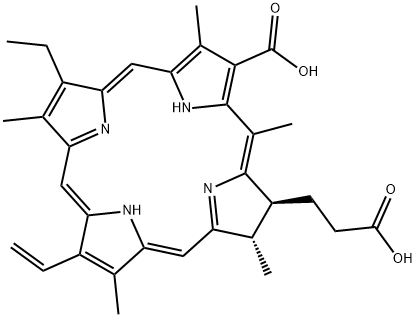


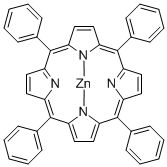
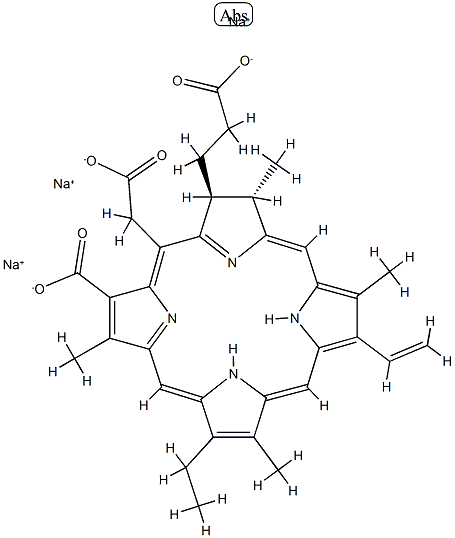
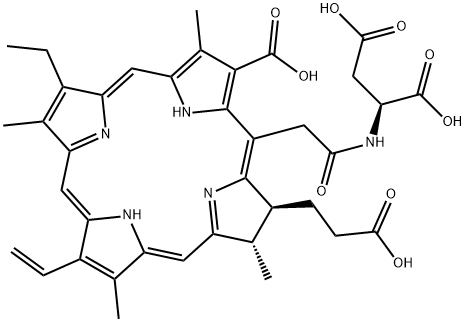

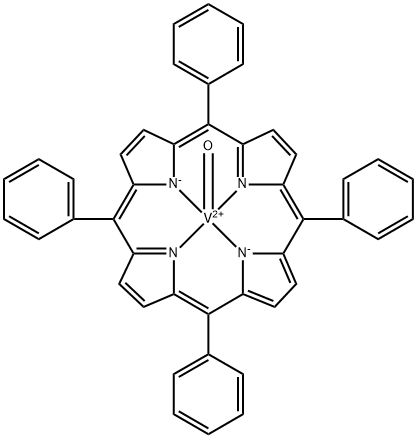
You may like
-
 Chlorin e6 95% CAS 19660-77-6View Details
Chlorin e6 95% CAS 19660-77-6View Details
19660-77-6 -
 100-71-0 99%View Details
100-71-0 99%View Details
100-71-0 -
 2 2-BIS(2-HYDROXYETHOXY)-1 1-BINAPHTHYL 99%View Details
2 2-BIS(2-HYDROXYETHOXY)-1 1-BINAPHTHYL 99%View Details
55441-95-7 -
 Chloro Uracil 1820-81-1 99%View Details
Chloro Uracil 1820-81-1 99%View Details
1820-81-1 -
 2-ethyl-6-methyl-3-hydroxypyridine succinate 127464-43-1 99%View Details
2-ethyl-6-methyl-3-hydroxypyridine succinate 127464-43-1 99%View Details
127464-43-1 -
 13162-05-5 N-Vinylformamide 99%View Details
13162-05-5 N-Vinylformamide 99%View Details
13162-05-5 -
 1446013-08-6 98%View Details
1446013-08-6 98%View Details
1446013-08-6 -
 Ste-Glu-AEEA-AEEA-OSUView Details
Ste-Glu-AEEA-AEEA-OSUView Details
1169630-40-3